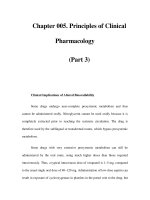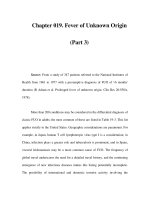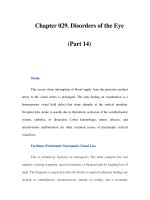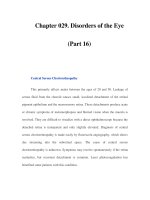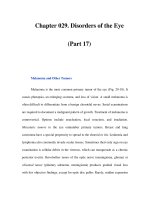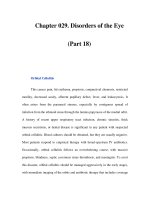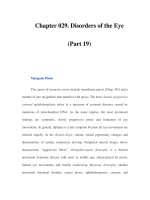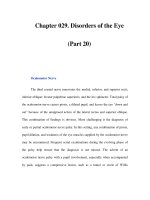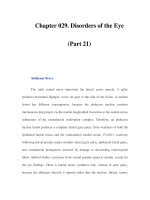Chapter 029. Disorders of the Eye (Part 3) pptx
Bạn đang xem bản rút gọn của tài liệu. Xem và tải ngay bản đầy đủ của tài liệu tại đây (15.36 KB, 5 trang )
Chapter 029. Disorders of the Eye
(Part 3)
Demonstration of a relative afferent pupil defect
(Marcus Gunn pupil) in the left eye, done with the patient fixating upon a
distant target.
A. With dim background lighting, the pupils are equal and relatively large.
B. Shining a flashlight into the right eye evokes equal, strong constriction
of both pupils.
C. Swinging the flashlight over to the damaged left eye causes dilation of
both pupils, although they remain smaller than in A. Swinging the flashlight back
over to the healthy right eye would result in symmetric constriction back to the
appearance shown in B. Note that the pupils always remain equal; the damage to
the left retina/optic nerve is revealed by weaker bilateral pupil constriction to a
flashlight in the left eye compared with the right eye. (From P Levatin, Arch
Ophthalmol 62:768, 1959.)
Subtle inequality in pupil size, up to 0.5 mm, is a fairly common finding in
normal persons. The diagnosis of essential or physiologic anisocoria is secure as
long as the relative pupil asymmetry remains constant as ambient lighting varies.
Anisocoria that increases in dim light indicates a sympathetic paresis of the iris
dilator muscle.
The triad of miosis with ipsilateral ptosis and anhidrosis constitutes
Horner's syndrome, although anhidrosis is an inconstant feature. Brainstem stroke,
carotid dissection, or neoplasm impinging upon the sympathetic chain are
occasionally identified as the cause of Horner's syndrome, but most cases are
idiopathic.
Anisocoria that increases in bright light suggests a parasympathetic palsy.
The first concern is an oculomotor nerve paresis. This possibility is excluded if the
eye movements are full and the patient has no ptosis or diplopia.
Acute pupillary dilation (mydriasis) can occur from damage to the ciliary
ganglion in the orbit. Common mechanisms are infection (herpes zoster,
influenza), trauma (blunt, penetrating, surgical), or ischemia (diabetes, temporal
arteritis). After denervation of the iris sphincter the pupil does not respond well to
light, but the response to near is often relatively intact. When the near stimulus is
removed, the pupil redilates very slowly compared with the normal pupil, hence
the term tonic pupil. In Adie's syndrome, a tonic pupil occurs in conjunction with
weak or absent tendon reflexes in the lower extremities. This benign disorder,
which occurs predominantly in healthy young women, is assumed to represent a
mild dysautonomia. Tonic pupils are also associated with Shy-Drager syndrome,
segmental hypohidrosis, diabetes, and amyloidosis. Occasionally, a tonic pupil is
discovered incidentally in an otherwise completely normal, asymptomatic
individual. The diagnosis is confirmed by placing a drop of dilute (0.125%)
pilocarpine into each eye. Denervation hypersensitivity produces pupillary
constriction in a tonic pupil, whereas the normal pupil shows no response.
Pharmacologic dilation from accidental or deliberate instillation of anticholinergic
agents (atropine, scopolamine drops) into the eye can also produce pupillary
mydriasis. In this situation, normal strength (1%) pilocarpine causes no
constriction.
Both pupils are affected equally by systemic medications. They are small
with narcotic use (morphine, heroin) and large with anticholinergics
(scopolamine). Parasympathetic agents (pilocarpine, demecarium bromide) used to
treat glaucoma produce miosis. In any patient with an unexplained pupillary
abnormality, a slit-lamp examination is helpful to exclude surgical trauma to the
iris, an occult foreign body, perforating injury, intraocular inflammation,
adhesions (synechia), angle-closure glaucoma, and iris sphincter rupture from
blunt trauma.
Eye Movements and Alignment
Eye movements are tested by asking the patient with both eyes open to
pursue a small target such as a penlight into the cardinal fields of gaze. Normal
ocular versions are smooth, symmetric, full, and maintained in all directions
without nystagmus. Saccades, or quick refixation eye movements, are assessed by
having the patient look back and forth between two stationary targets. The eyes
should move rapidly and accurately in a single jump to their target. Ocular
alignment can be judged by holding a penlight directly in front of the patient at
about 1 m. If the eyes are straight, the corneal light reflex will be centered in the
middle of each pupil. To test eye alignment more precisely, the cover test is
useful. The patient is instructed to gaze upon a small fixation target in the distance.
One eye is covered suddenly while observing the second eye. If the second eye
shifts to fixate upon the target, it was misaligned. If it does not move, the first eye
is uncovered and the test is repeated on the second eye. If neither eye moves, the
eyes are aligned orthotropically. If the eyes are orthotropic in primary gaze but the
patient complains of diplopia, the cover test should be performed with the head
tilted or turned in whatever direction elicits diplopia. With practice the examiner
can detect an ocular deviation (heterotropia) as small as 1–2° with the cover test.
Deviations can be measured by placing prisms in front of the misaligned eye to
determine the power required to neutralize the fixation shift evoked by covering
the other eye.
